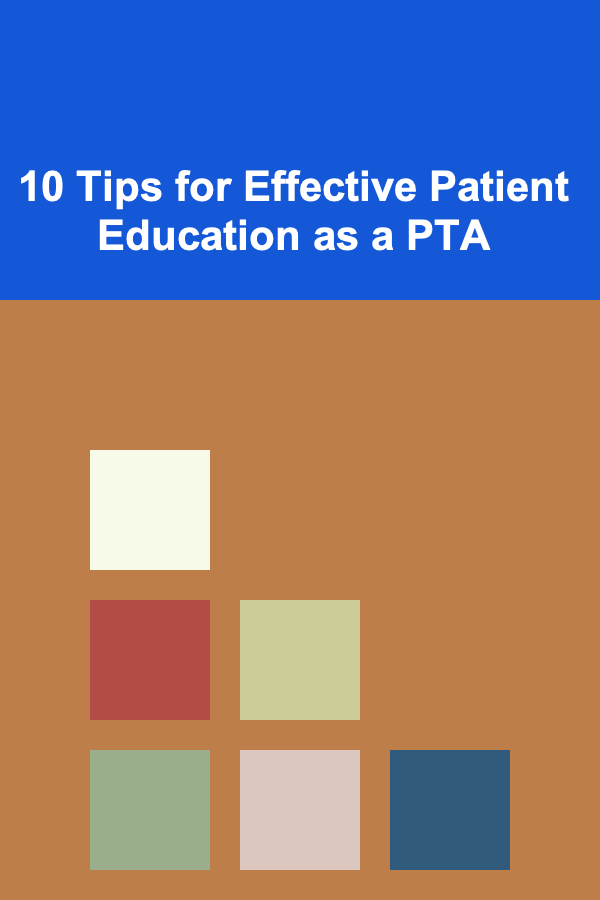
10 Tips for Effective Patient Education as a PTA
ebook include PDF & Audio bundle (Micro Guide)
$12.99$7.99
Limited Time Offer! Order within the next:

Patient education is a cornerstone of physical therapy practice. As a Physical Therapist Assistant (PTA), your role extends beyond simply assisting with treatments and exercises. You are a key player in ensuring patients understand their conditions, treatment plans, and what they can do at home to optimize recovery. The success of a physical therapy program often depends on how well the patient understands their role in their recovery process.
Effective patient education not only improves patient outcomes but also builds a relationship of trust and cooperation between the patient and therapist. However, educating patients isn't always straightforward. Different patients have different needs, learning styles, and levels of understanding. As a PTA, it's crucial to adapt your educational approach to suit these differences.
In this article, we will discuss 10 tips for providing effective patient education as a PTA. These tips will help you improve your communication with patients, ensure they understand their treatment plans, and empower them to take an active role in their rehabilitation.
Create a Comfortable Learning Environment
Before you even begin to educate your patient, it's important to create an environment where they feel comfortable and open to learning. A patient who feels at ease is more likely to engage in the educational process. Here's how to foster that environment:
- Minimize Distractions: Ensure the room is quiet and free from interruptions.
- Establish Rapport: Take time to introduce yourself and engage in small talk. Showing empathy and listening to your patients can help them feel valued and understood.
- Use a Calm, Supportive Tone: Speak slowly, clearly, and confidently. Avoid using jargon that could confuse the patient. Use positive, encouraging language.
Know Your Audience
Each patient is unique, so understanding their learning preferences, cultural background, and health literacy is critical to tailoring your education. Some patients may learn better through visual aids, while others may prefer hands-on demonstrations or verbal instructions. Take the time to understand your patient's background, such as:
- Age: Older patients may require more repetition or visual aids, while younger patients may prefer more technological interactions.
- Health Literacy: Some patients may struggle with medical terminology, so simplify your language when explaining anatomy or diagnoses.
- Learning Style: Some patients learn best through doing (kinesthetic learners), while others may prefer listening or seeing information (auditory and visual learners).
Adapting your teaching to the patient's learning style is crucial to ensuring they retain important information.
Set Clear and Realistic Goals
Patient education should be goal-oriented. When you start a patient's physical therapy program, it's important to set clear, achievable goals for their recovery. These goals should be realistic and based on the patient's condition, abilities, and progress.
- Collaborative Goal Setting: Engage the patient in the goal-setting process. When patients feel like they are a part of the decision-making, they are more likely to take ownership of their recovery.
- SMART Goals: Ensure that goals are Specific, Measurable, Achievable, Relevant, and Time-bound. This approach provides clarity and direction for both the patient and the PTA.
For example, instead of a vague goal like "increase strength," a more specific goal would be "increase knee extension range of motion by 10 degrees within four weeks."
Use Visual Aids to Reinforce Learning
Visual aids can significantly enhance a patient's understanding of their condition, treatment plan, and exercises. People process and retain information better when they can see a visual representation.
- Anatomical Models or Diagrams: Use these to explain the body parts involved in the patient's condition.
- Exercise Demonstrations: Show the patient how to properly perform exercises, then have them practice while you guide them.
- Written Instructions: For complex exercises or home care instructions, provide printed or digital materials that patients can refer to later.
Visual aids can be particularly helpful for patients with limited health literacy or those who need more detailed explanations of their anatomy or movement patterns.
Simplify Complex Information
As a PTA, you may often need to explain complicated medical concepts or treatment plans to your patients. The key to successful patient education is simplifying this information without compromising the accuracy of your message. Some strategies include:
- Use Analogies: If a patient is having difficulty understanding a concept, try using a familiar analogy. For example, you might describe the joints in the body as hinges on a door to explain how they move.
- Break Information Down into Small Pieces: Avoid overwhelming patients with too much information at once. Provide information step by step, and check for understanding along the way.
- Use Layman's Terms: Rather than using complex medical terminology, explain things in plain language. For example, instead of saying "posterior cruciate ligament," say "a ligament in the knee that helps with stability."
Encourage Active Participation
An essential aspect of patient education is getting patients actively involved in their recovery. When patients engage in their rehabilitation process, they are more likely to stick with the treatment plan and experience better outcomes. Encourage participation by:
- Hands-on Practice: Show the patient how to perform exercises and then have them practice with you. Correct their technique as needed, and praise them for their effort.
- Self-Management: Educate patients about self-care strategies they can do at home, such as exercises, stretches, and proper posture.
- Ask for Feedback: During the session, ask patients to share their thoughts, concerns, and challenges. This feedback will help you tailor your approach and adjust the plan accordingly.
Incorporate Technology
In today's world, many patients are tech-savvy and may respond well to digital tools that support their physical therapy. Consider integrating technology into your patient education plan:
- Apps: Use apps to help track progress or remind patients about exercises. Some apps even offer instructional videos that patients can follow at home.
- Videos: If appropriate, provide patients with video demonstrations of exercises so they can watch them at home.
- Telehealth: For patients who cannot attend in person, telehealth consultations can be an effective way to continue education remotely.
Reinforce Education with Written Materials
Sometimes patients may forget information after the session or have questions later. Providing written materials reinforces the key concepts discussed and offers a reference for patients when they are at home. You can provide:
- Exercise Handouts: Provide clear, easy-to-understand instructions for exercises, including illustrations if possible.
- Condition Overview: Offer a handout explaining the patient's condition in layman's terms, so they better understand their diagnosis and treatment options.
- Tips for Managing Symptoms: Provide strategies to manage symptoms like pain, swelling, or fatigue.
Be sure to explain these materials during the session and encourage the patient to bring them home for reference.
Be Patient and Use Active Listening
Education is a two-way process. As a PTA, you must be patient and willing to listen actively to your patients' concerns, questions, and feedback. This shows that you value their input and helps you understand how best to approach their learning. Active listening involves:
- Making Eye Contact: This shows you are focused and engaged in the conversation.
- Nodding and Verbal Acknowledgement: Respond to their concerns by nodding or offering simple affirmations like "I understand."
- Avoiding Interruptions: Allow patients to finish speaking before you respond. This ensures you fully understand their concerns and questions.
Follow Up and Reinforce Learning
Patient education doesn't stop once the session ends. Regular follow-up can help reinforce what patients have learned and allow you to assess whether they are adhering to the treatment plan. Some strategies for effective follow-up include:
- Phone Calls or Emails: Check in with patients between sessions to see how they are doing and remind them of key points.
- Revisit Education Regularly: During each session, take time to review previous educational points, ensuring that patients continue to grasp the information.
Patients may also need ongoing motivation, so be sure to offer praise and encouragement as they make progress.
Conclusion
As a Physical Therapist Assistant, your role in patient education is crucial to the success of treatment. By creating a comfortable learning environment, personalizing education for each patient, and using clear communication techniques, you can help patients take an active role in their recovery. These 10 tips will guide you in providing effective, patient-centered education that supports rehabilitation, fosters understanding, and empowers patients to reach their full potential.
Reading More From Our Other Websites
- [Personal Investment 101] Creating AI Products That Generate Passive Income with Deep Learning
- [Home Rental Property 101] How to Prepare Your Rental Property to Attract Tenants Looking for Apartments with a Dog Run
- [Personal Care Tips 101] How to Use Lip Balm to Keep Your Lips Smooth During the Night
- [Home Holiday Decoration 101] How to Set Up a DIY Hot Cocoa Bar as a Holiday Feature in Your Home
- [Tie-Dyeing Tip 101] Bleach-Infused Tie-Dye: A Beginner's Guide to Bold, Unexpected Patterns
- [Home Holiday Decoration 101] How to Craft Unique DIY Holiday Centerpieces for Every Room
- [Biking 101] Bike Derailleur Maintenance: How to Keep Your Gears Shifting Smoothly
- [Home Space Saving 101] How to Create Vertical Storage Ideas for Small Spaces
- [Organization Tip 101] How to Create a Timeline Wall for Music Projects
- [Home Holiday Decoration 101] How to Decorate Your Living Room for the Holidays

How to Create a Cozy and Festive Holiday Atmosphere
Read More
How to Keep Your Garage Organized and Well-Maintained
Read More
How to Make Your Home Party More Inclusive for All Guests
Read More
How to Track Your Monthly Expenses Effectively
Read More
How to Explore Synthetic Biology and Bioengineering
Read More
How to Feng Shui Your Kitchen to Attract Abundance
Read MoreOther Products

How to Create a Cozy and Festive Holiday Atmosphere
Read More
How to Keep Your Garage Organized and Well-Maintained
Read More
How to Make Your Home Party More Inclusive for All Guests
Read More
How to Track Your Monthly Expenses Effectively
Read More
How to Explore Synthetic Biology and Bioengineering
Read More